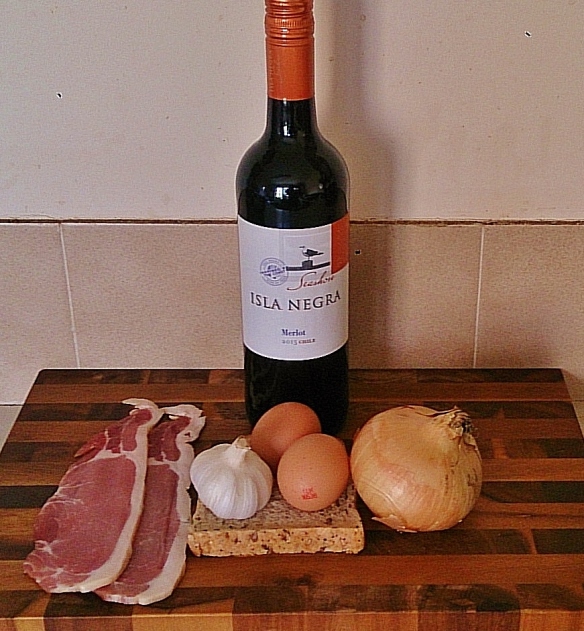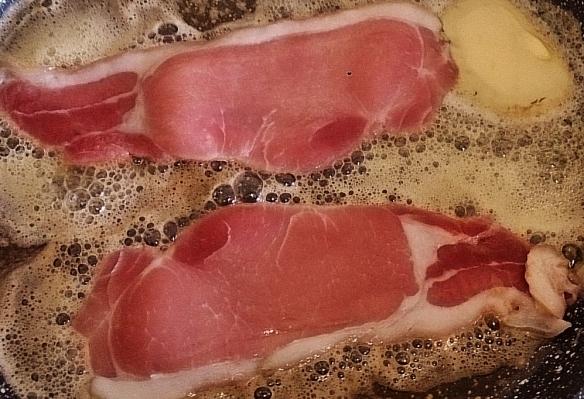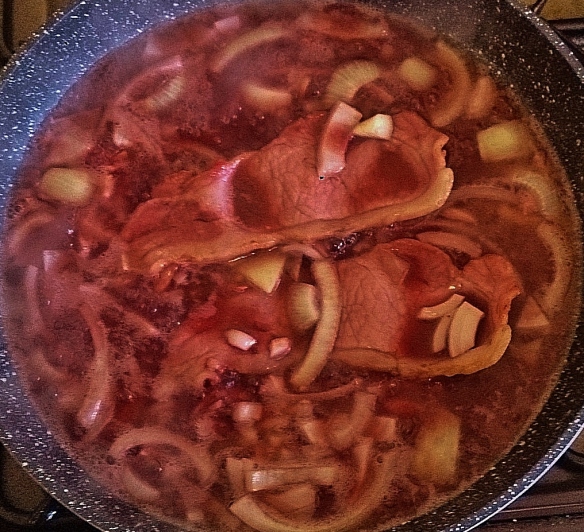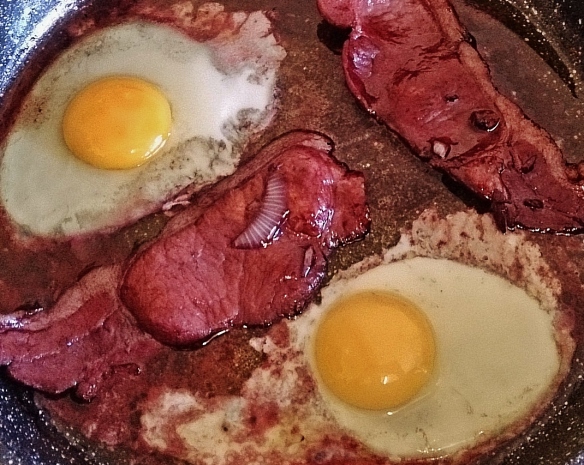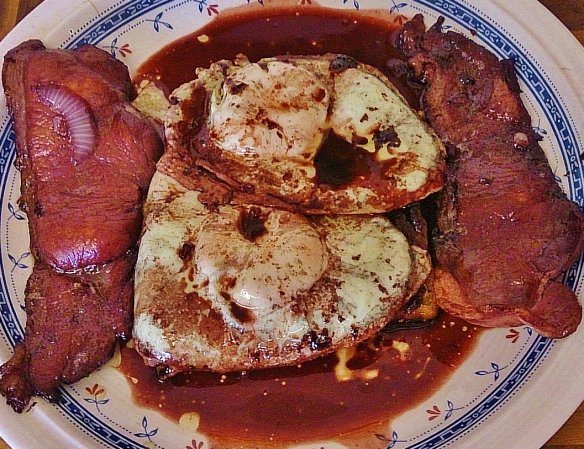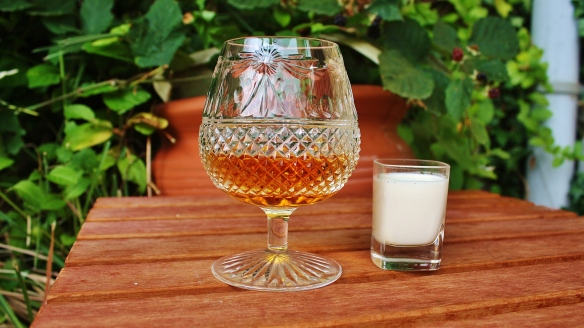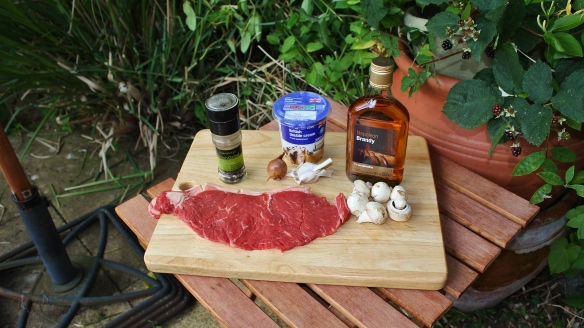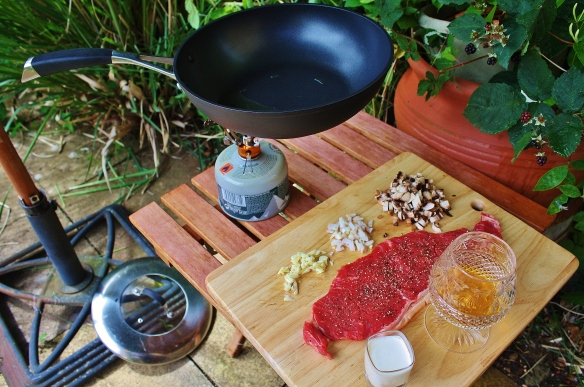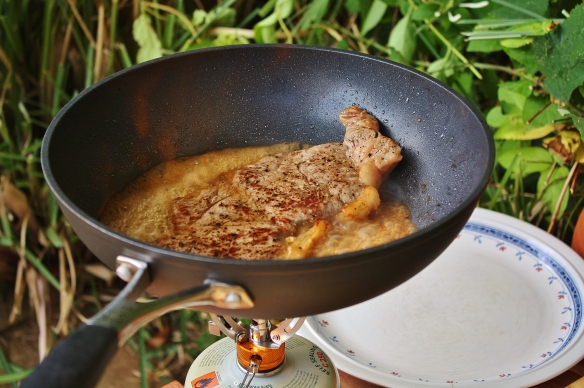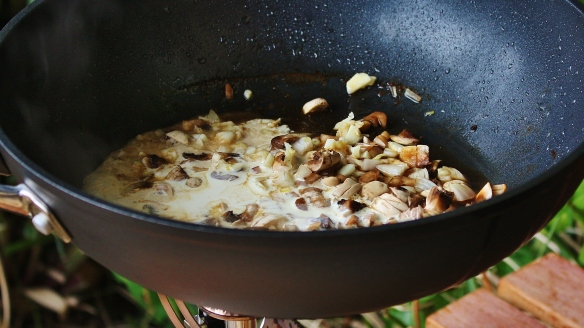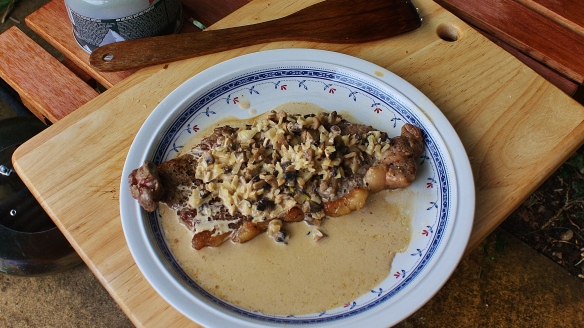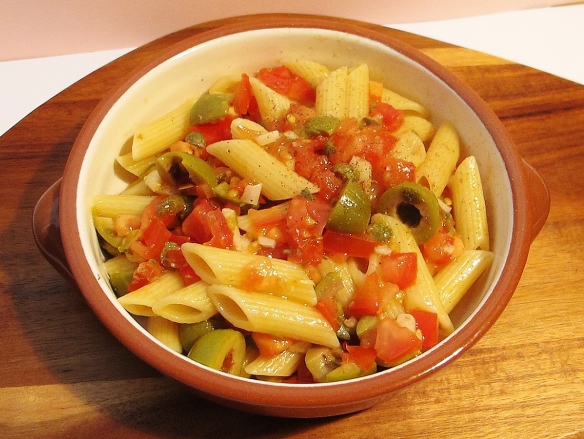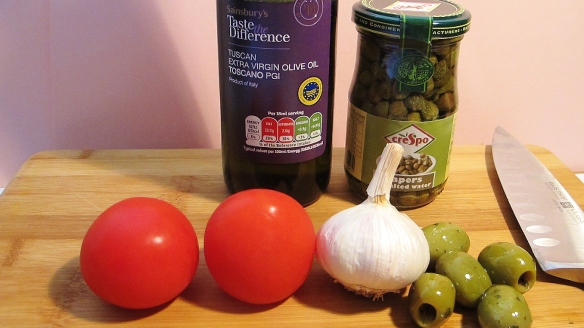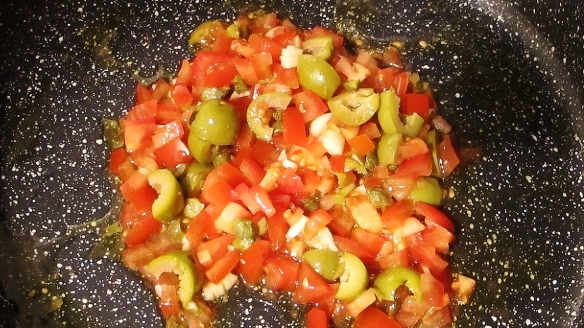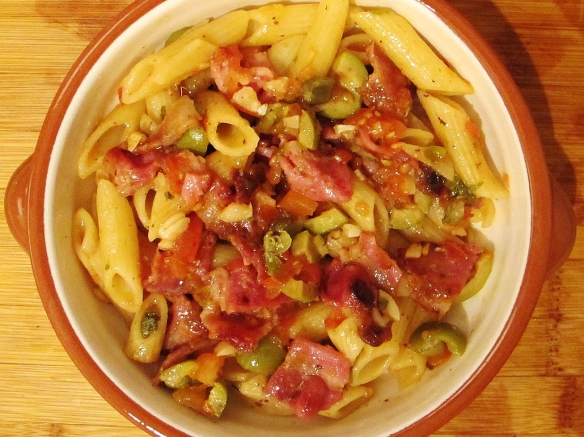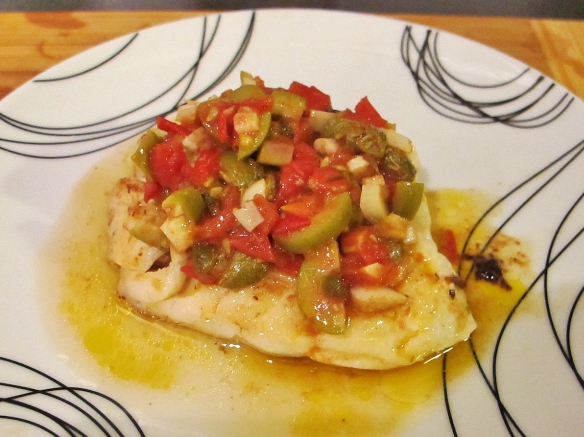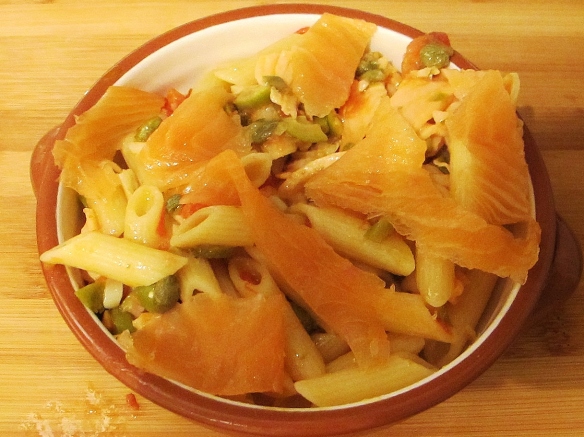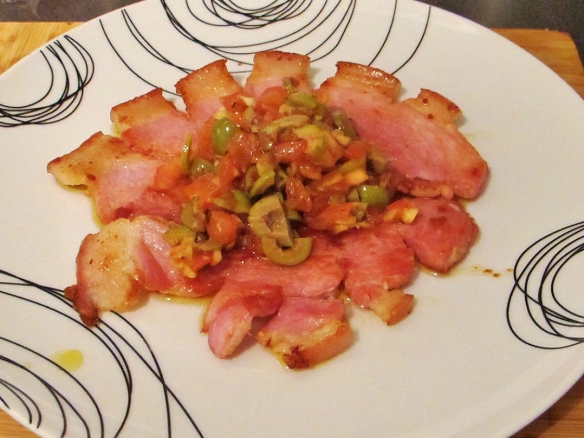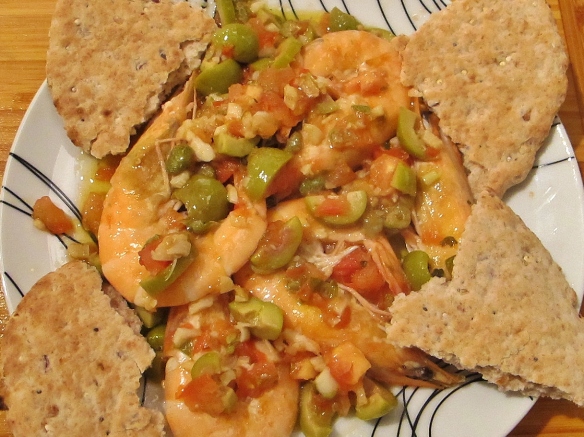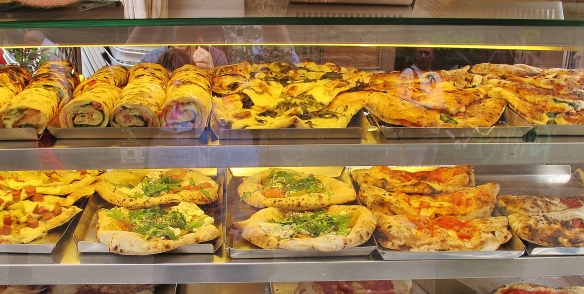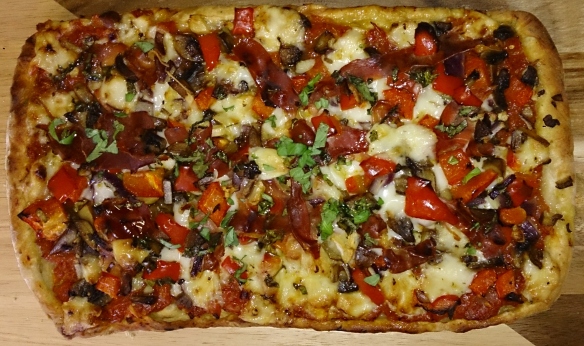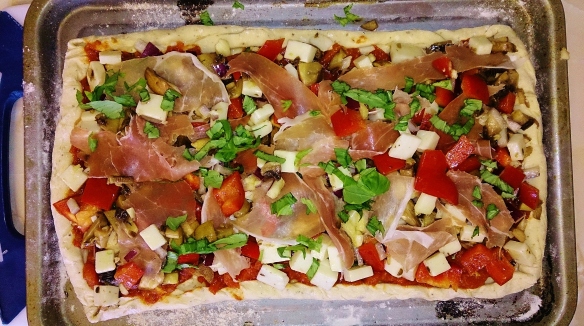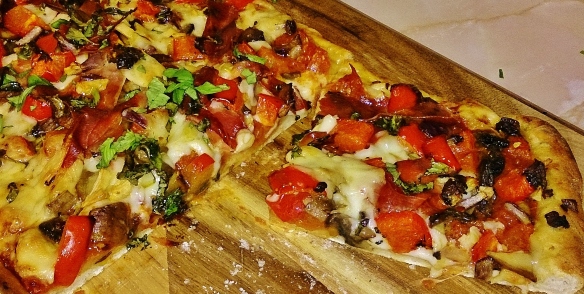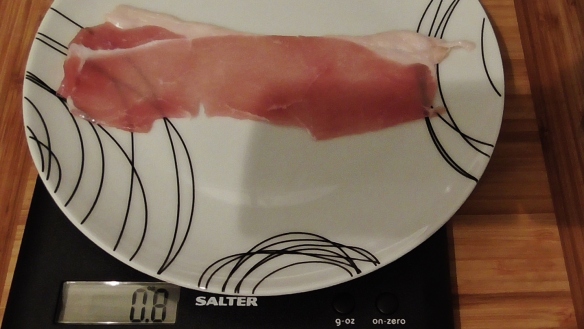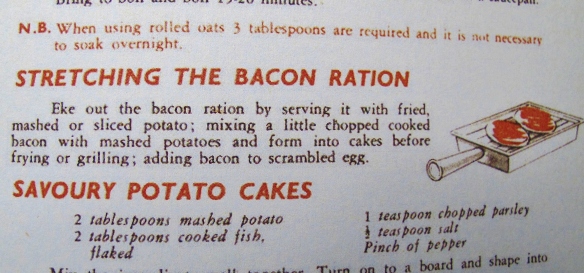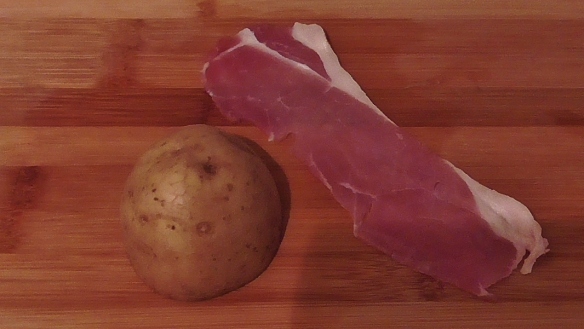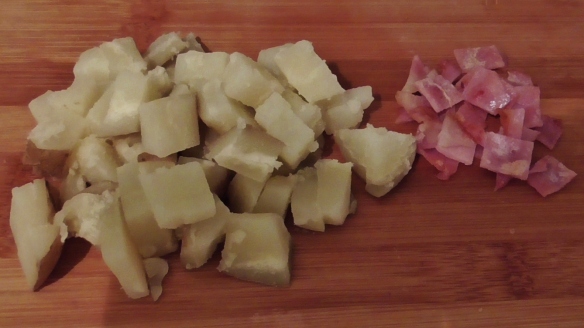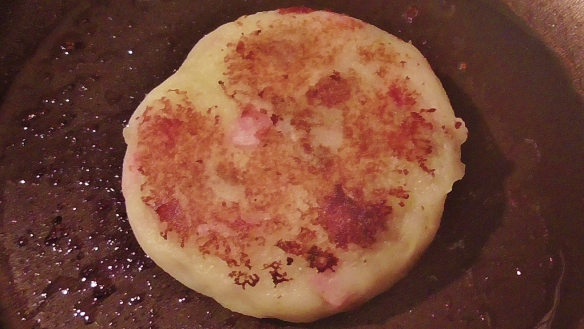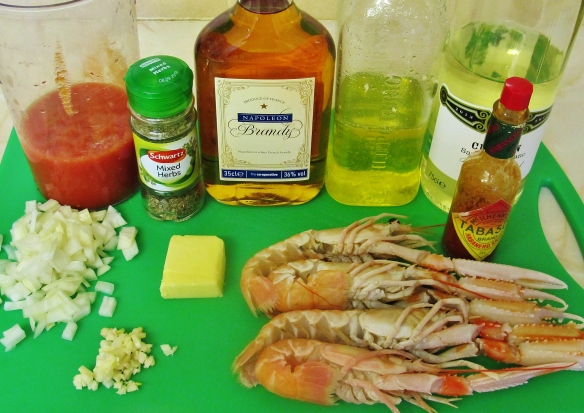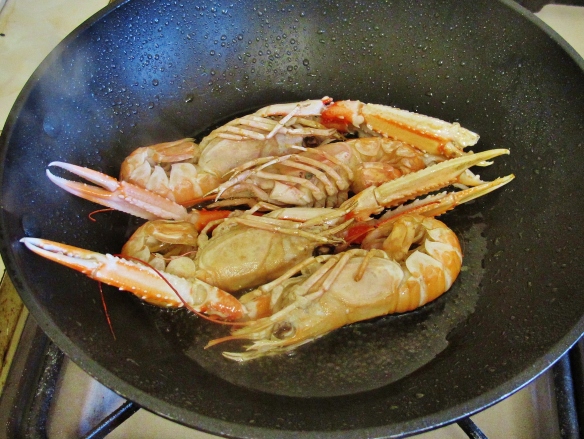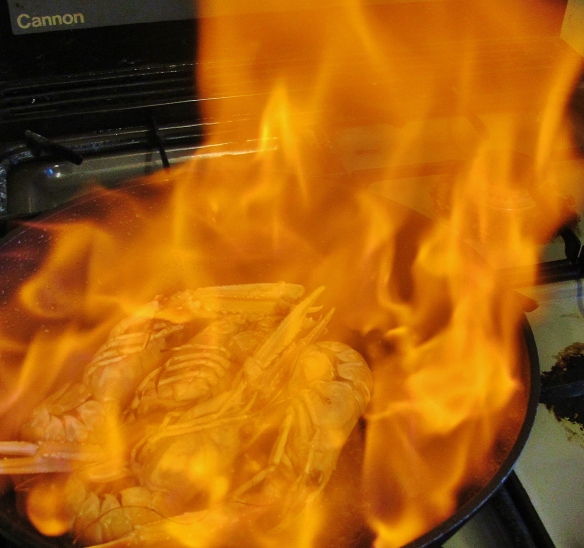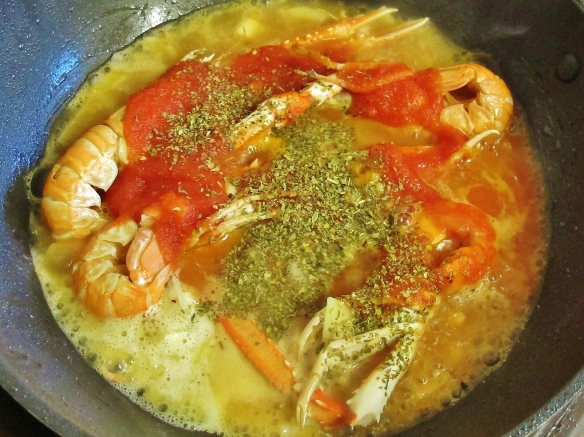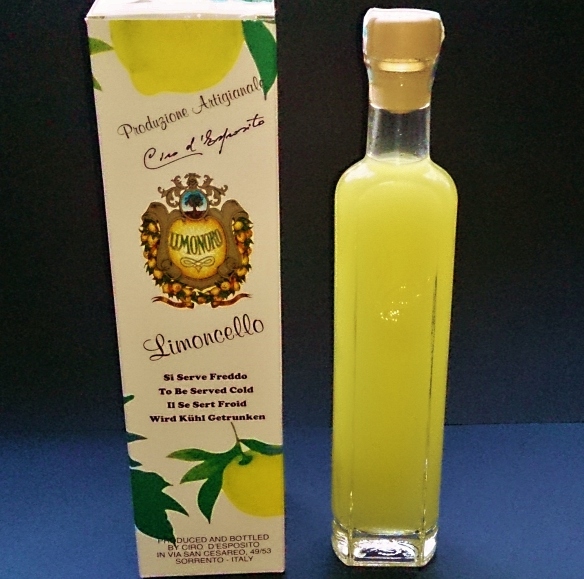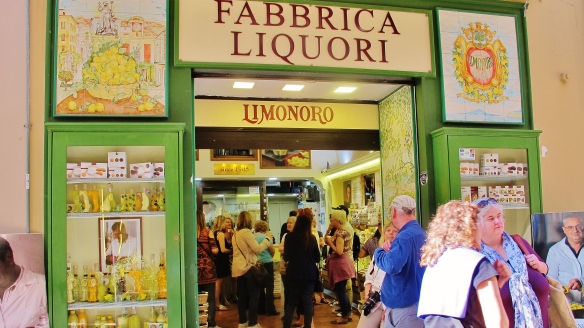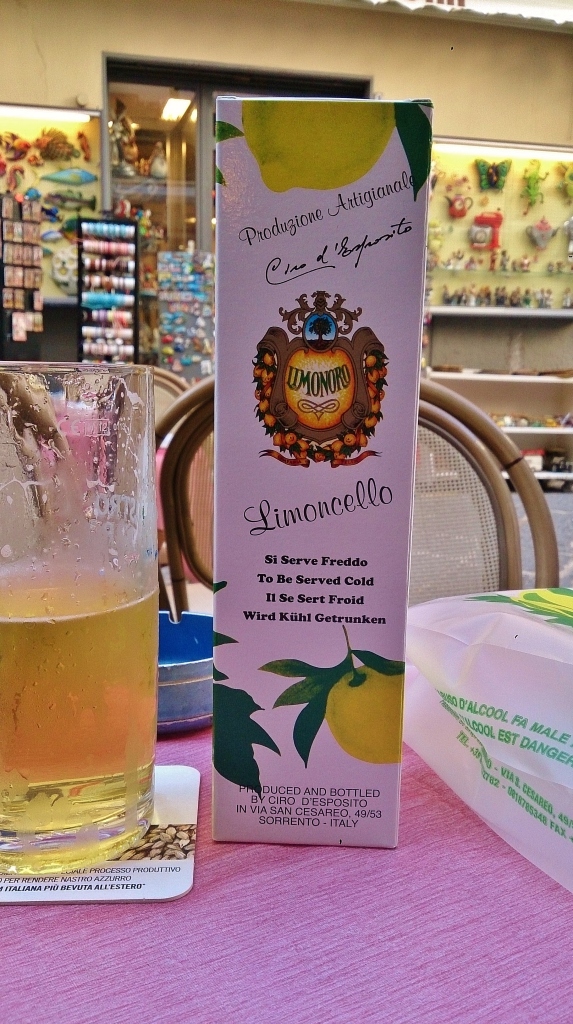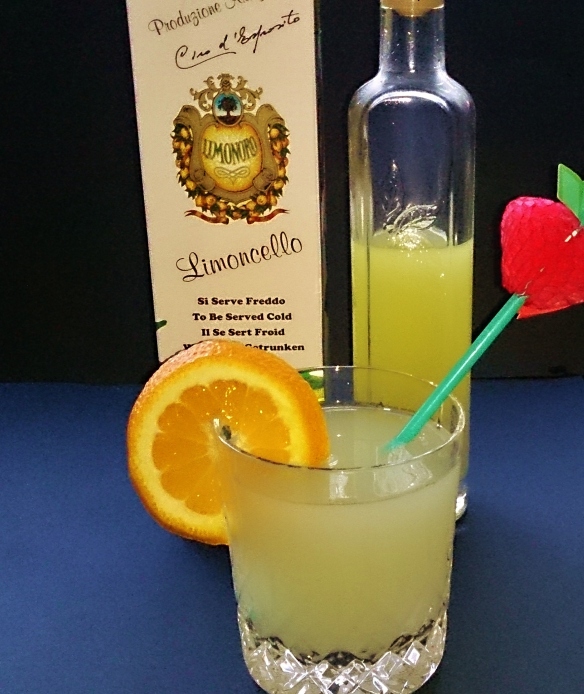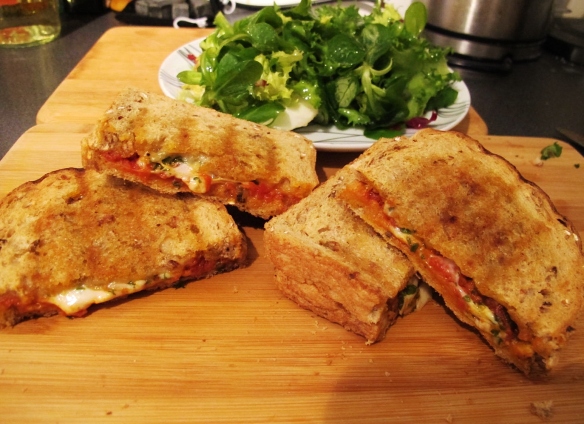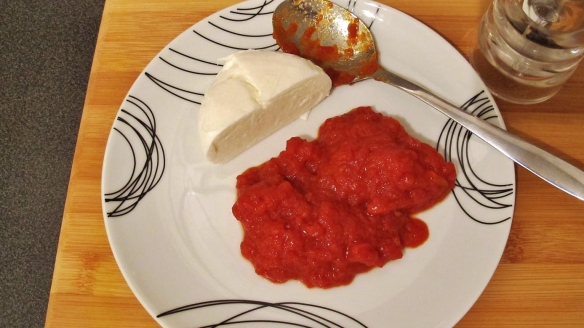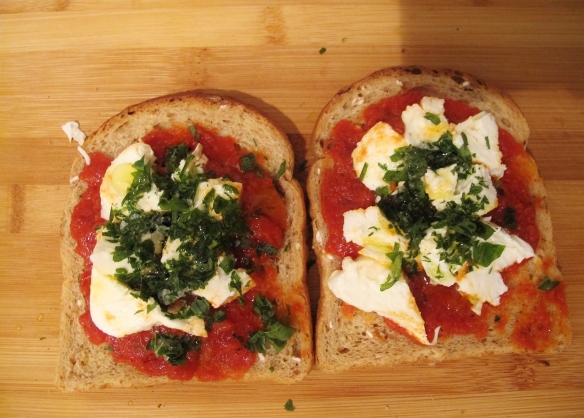Oeufs en Meurette (Eggs in Wine Sauce)
The ingredients: Eggs, bacon, red wine, onion, garlic and a slice of bread.
Fry the bacon in some butter. Add some onion and garlic to the pan and soften down. Then add in roughly 1/3 to ½ bottle of red wine and rapidly reduce to, say, half maybe less.
Strain the sauce of the onion and garlic (use later on in a stew or piperade) and return to the pan. Add a couple of eggs and poach. Put the eggs onto a slice or two of fried bread and pour over the sauce.
And here we are. Apparently Michel Roux Jr used to make this for French President Francois Mitterrand as a breakfast!
(It is much better than the image may suggest. I’ve tried and tried to get a decent image of this and not really succeeded. I’m not a professional food photographer or food stylist.)
Steak with Sauce a la Creme
Aside from the steak, these are the essential ingredients:
Brandy and double cream. Everything else is an add on. Having said that, a really good blast of pepper is really good.
Personally, I always think a really good piece of steak needs nothing doing to it. However, a really good piece of steak can be hard to come by sometimes. In that eventuality, then this is a sauce which can make quite a difference!
Just as an aside, switch the brandy for calvados, the steak for pork and some of the onion with apple and you have one of my ultimate favorate things! But that’s for another day.
Fry off the steak to you preferred level of doneness and add the brandy.
Flambe and reduce. If you want to add butter then this is a good time to do it. For me, butter make this too rich.
Remove the steak to a hot plate to rest. While the steak is resting add onion, garlic and mushroom to the pan and soften down. As things start to soften add in the double cream.
Don’t add in too much cream or you will wreck it. A teaspoonful at a time and keep testing until you’ve got it. When the sauce is properly cooked through and pour over the steak.
This is really good with plain boiled potatoes and those small green beans. And a good bottle of red wine.
Pasta Alla Puttanesca
Pasta Puttanesca. Pasta for ladies of easy virtue?
All you need: Olive oil (extra virgin), capers, olives, garlic and tomato. Another version of this also includes anchovies. Generally, black olives are used. I prefer green olives. Adding in a little basil or parsley does no harm.
Dice everything up and thoroughly heat through in a pan with a good slug of virgin olive oil.
When finished toss into pasta. This version uses diced smokey bacon (even better with prosciutto).
How stupid simple is this? Fast, fresh and simple. Truly fantastic. Really fresh and really tasty and so versatile! For those who need something quick and easy to throw together on the hoof, on a busy work day, then this is a must have in the repertoire. It isn’t just good for pasta. How about using it to liven up a piece of fish.
Maybe add in some smoked salmon.
As an accompaniment to a piece of gammon maybe (this is really good).
Or how about with prawns and garlic bread.
Is there anything this can’t be used with? This sauce is so good and so clever it’s amazing. Seriously amazing.
Puttanesca Sauce
I first came across this brilliant little sauce many years ago in Claudia Rodens book on Mediterranean cookery where she says the source of the name is a mystery. More recently I saw this on Nigella Lawson’s website and featured in one of Rick Steins’ DVD’s. You will see it in many books on Italian food, although rarely labeled ‘Puttanesca’. Usually this is labeled as olive and caper sauce. The Italian word “puttana” literally translates to “whore” or “prostitute”. So literally, “pasta of the whores”. The idea being, according to some, that this is something quick and simple for “the generous ladies of Naples” to make on a busy work day between clients! Personally, I see this usage as a little bit of mischief. No doubt, for some, the name makes for fun dinner party conversation after a few glasses of wine! Another way to look at this name is simply as a graphic way to imply something cheap and easy. A sure thing. “even a Naples prostitute can make this!” (with due apologies and respect to the good ladies of Naples!).
In summary this great little sauce is cheap, easy and will pretty much go with anything.
Pizza ‘al taglio’ (“by the slice”).
“Italians have been doing quality street food much longer than us (the British) , and make less of a fuss about it”
“Designed to be held in the hand and eaten on the hoof, this is baked slower and longer in trays, so it gets a crispy bottom. It has a slightly thicker crust and a wonderfully chewy crumb with big, open bubbles.”
“Foods like this allow us to loiter in archways, stroll down streets and wander through piazzas.”
The above quotes are from Jacob Kenedy, chef patron at Bocca di Lupo and Vico, taken from an article published in the Financial Times. The images were added by myself.
Everywhere I go in Italy There seem to be stalls opening to the street selling this stuff. All of it looks fantastic. Also, it is a reminder to me that whilst there are the wonderful classic pizza’s we can adapt to circumstances. After all, these kinds of foods were invented out of pragmatism.
Pizza Doesn’t have to be Round
You don’t even necessarily have to use a wood fired oven or a stone. But I must admit, I do like using a stone.
On a cheap, well-loved, non-stick baking tray generally sprinkle some flour to aid the non-stickiness. Make a base in your own favourite way and arrange on top. I like to crimp the edges of the dough so it makes a kind of tray. Reduce some tinned tomatoes in a pan. How far you go with this is up to you. I like mine quite thick to get quite a strong flavour. Spread on top, but don’t use too much, and sprinkle with ripped basil.
Dice up some onion, mushroom, bell pepper and cheese (take your pick). Get this mixture well mixed in a bowl with a good generous slug of olive oil. Put on top and spread in some prosciutto. Bake on gas mark 4 or 5.
When done, throw on some more ripped basil as a garnish.
Stretching the Bacon Ration
From what I can gather, this is a weeks bacon ration for one person in the UK in WW2. Even this miserably small quantity is the very, very best I can find. Other sources I have read suggest the ration was only half this amount. The reader should realise this is what could be taken home. That doesn’t necessarily mean that there would even be this much available to buy. There were other options though. For example, restaurants, for those who could afford it, went un-rationed in terms of quantity although they were rationed by price. In turn, they also had restrictions and could only buy in what was available. For those engaged in war work also had other options such as the workplace canteen. Then there was the British restaurant. These “communal feeding centres” were created for those bombed out of their homes, run out of food stamps or otherwise needed help. Another option, I’ve been told about from those who were there at the time, was to keep a pig. This could be done individually or as a community co-operative of some kind. However, anyway you look at it, bacon, like many foods, was a scarce resource.
I recently came across a book called “Eating for Victory”, “Healthy home front cooking on war rations” (ISBN 978-1-78243-026-1). This book describes itself as “Reproductions of official second world war instruction leaflets”. Inside this book I found this:
So then, this is it:
Well, from our time, it doesn’t look very promising does it? But then, it is what it is, and you just have to make do with what you’ve got and get on with it. What else is there to do? After all, there is a war on you know.
I’ve pre-cooked the bacon as lightly as I dare. Even this has reduced the weight from 8oz to 5oz. Imagine if you only started with 4oz? One thing I will not do is clean out the frying pan. I need to extract every minimal amount of flavour I can get.
And here it is. Frankly, the potato completely swamps the bacon. If what I have done here in any way represents the reality of the time then I think I would have despaired. There was always the black market option I suppose. If it were me, back then, I think I would have used the ration as a flavouring. Fried to nearly crispy, very finely diced and sprinkled onto other things to make them more palatable. How lucky we are.
This posting is dedicated to the good work of the Women’s Institute (soon to celebrate it’s centenary) the W.V.S. (later R.W.V.S) and the late, great Marguerite Patten CBE.
Langoustines Vauclusienne
Firstly, an admission. This is a straight steal from my food hero Keith Floyd. Do you realise that 2015 marks 30yrs since Floyd on Fish hit network television? Amazing.
What you need: Langoustines, tomato sauce, onion, garlic, brandy, white wine, chilli sauce, olive oil, butter.
Cook the langoustines in some olive oil with the onion and gently flambé.
Add in the white wine and reduce for a minute or two. Then add in the rest.
This is really good, really simple and so typical of Floyd. Here is the clip. Notice the philosophy on his approach. See what’s good, buy it and THEN decide how to cook it!
Shooting the Cook
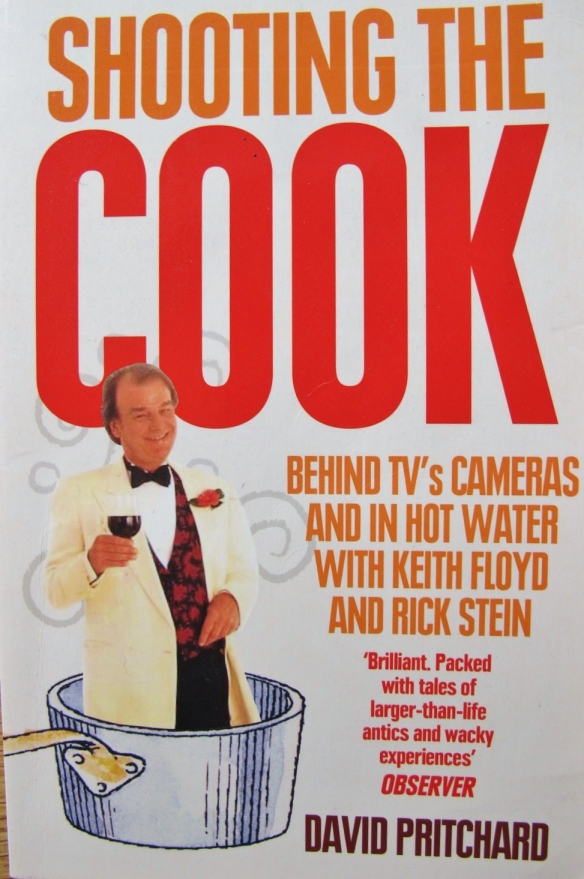
“Shooting the Cook” is a memoir written by TV producer, director and, alongside Keith Floyd, legendary maker of television food programmes. I suppose the most well-known quote from the book is this,
“Cooks on television,” Keith pronounced “could be as famous as rock musicians and racing car drivers”
Here’s another quote which I particularly like,
“they” (television producers) “come in to my restaurant pissed out of their heads, promising me the earth with my very own series. I break open my very best brandy, then they piss off and I never see them again”.
Fortunately for us they did see each other again. Amongst other things this book wonderfully describes the behind the scenes story of the 1985 TV series ‘Floyd on Fish’ often regarded as the one which kicked down the door on the subsequent cult of the celebrity TV chef in the years that followed. The best part of this story is that its success was all an accident! For people like me who are addicted to TV food programmes and occasionally dabble in the kitchen or maybe even have the pretentions to maintain a food blog this is a must read. It is a must read because this is where it all started.
Until Floyd and Pritchard the stereotype TV cooking show was a very stayed, studio based, educational, domestic science, type of affair. The stereotype isn’t true of course. Even Pritchard admits the Floyd programmes were heavily influenced by the Galloping Gourmet (Graham Kerr, “the James Bond of cooking”). Also, correct me if I’m wrong, but isn’t Fanny Craddock the only TV cook to have played the Albert Hall? Complete with evening dress and husband Johnny in tuxedo? Still, however you look at it what they did was extraordinary for its time. They took cooking out of the TV studio and into the real world. They smashed the mystique of the restaurant kitchen. They went out on the trawlers. They went to the farms. They showed us were the ingredients come from. They showed us organic and free range. Food and cooking became a fun and exciting adventure. In short, “Floyd made it OK for blokes in pubs to have conversations about chillies and coriander”. Here is one last quote from the book which, for me, sums up the whole phenomenon.
“Forget about exact ingredients, pour yourself a glass of wine and relax. Peel a couple of cloves of garlic and make the whole cooking experience far more enjoyable than going out to a restaurant.”
Bon appetit.
Limoncello
Limoncello is a strong, Italian liqueur made from the zest of sfusato lemons. This spirit is mostly associated with the southern part of the gulf of Naples and the Amalfi coast where the sfusato lemon is a common crop. Limoncello can be either clear or opaque.
I recently went on a short break to the town of Sorrento which sits high on the cliffs on the southern coast of the bay of Naples, Italy. This wonderful little town has a lot to offer the tourist looking for a chill out. Including this place.
This great little shop sells Limoncello everything. Even limoncello soap, apparently. Inside this alladin’s cave of yellow with its vast array of all kinds of shapes and sizes of bottles, boxes of sweets the staff eagerly ply visitors with small samples.
It is one of those places where one really has to buy something. Why? Because I can think of no where outside of this part of the world like it. So I did.
Having bought my bottle I then, as is my habit, retired to a street side bar/café for a beer to ponder my new purchase and announce my latest adventure on Facebook.
Cue my good friend and culinary genius Chef Instructor Terri Dien.
Mike: “Hey Terri, look what I just bought. This stuff is quite potent! I think this stuff has potential for dilution in soda water or tonic water”.
Terri: “Lovely, Mike! Yes, drink it straight and you might not be able to stand up straight… but added to soda is a great way to enjoy it….. over a scoop of ice cream or sorbet…. Yum. I also add some to buttercream when I’m making special occasion cakes ”.
Terri: “Limoncello (from Italy) is available here (California) in most stores… we can also make it, too! Paul and I made a batch years ago that’s still in our freezer. But I’m sure it tastes even better where you’re sitting!”
Mike: “Can I quote you in a blog post?”
Terri: “Of course!”
Mozzarella and Tomato Toasties
I’ve been indulging in one of my favourite stress busters. Playing in the kitchen. I’m not going to tell you what it is I’ve been playing with because that could, potentially, spoil a future blog. Although, I suspect, you could give it a good guess……
I just happen to have some left over tomato sauce and some Mozzarella cheese. The sauce is made from a reduction of roughly 50/50 fresh (just off the vine) and tinned tomatoes well reduced. No onion, no garlic, just tomato and nothing else. It is this sauce base that really makes this very modest little toastie so brilliantly and wonderfully fantastic that I just had to tell you about it.
Spread the sauce over slices of bread. Dot with mozzarella and add a little ripped up basil (By the time I got around to making images I ran out of basil and used parsley, but you get the idea).
Add another slice on top and toast any way you like. I imagine this would be just as good as an open sandwich too. Serve with a simple green salad.
I love cooks treats don’t you?

